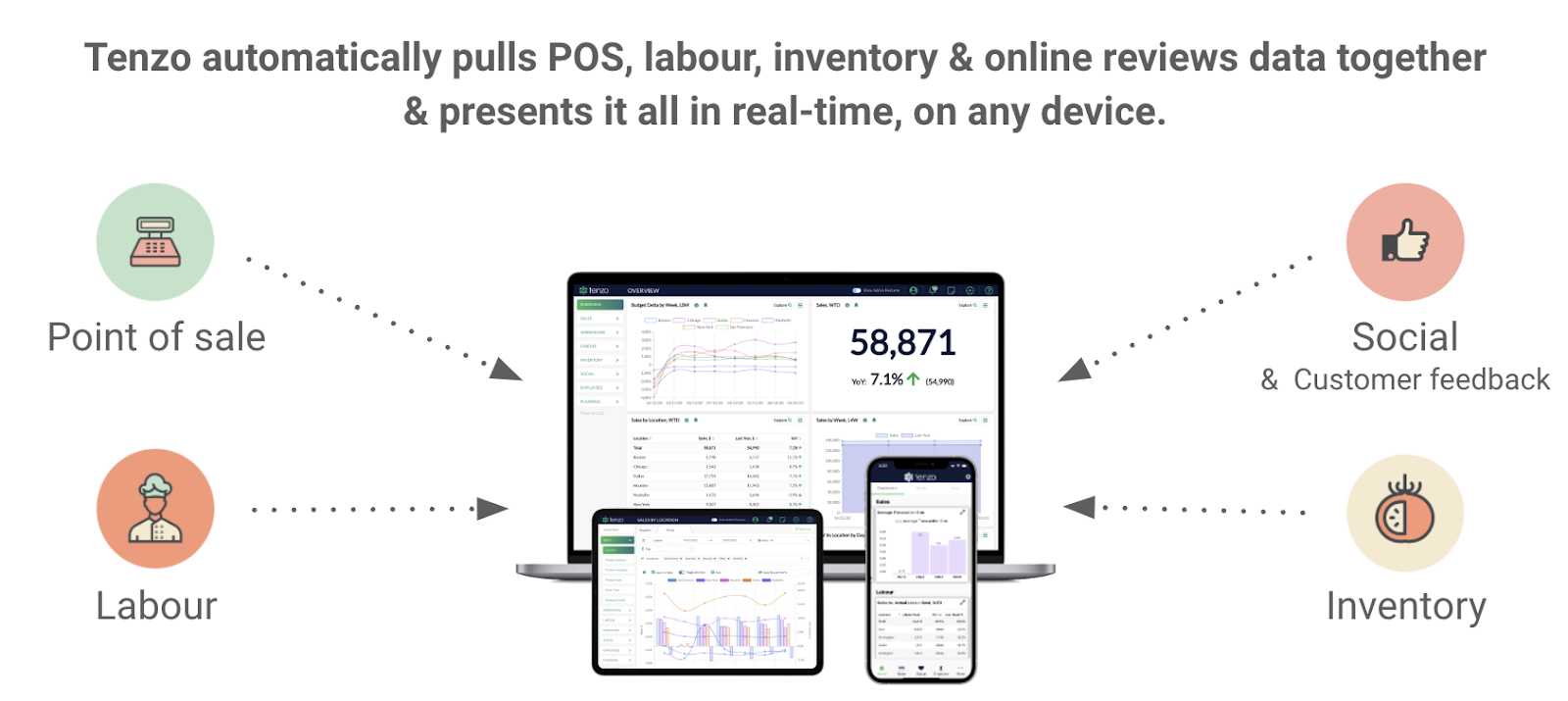Mark Withington, Tenzo’s Enterprise Sales Director, reflects on the problems restaurant operators run into time and time again when it comes to restaurant targets and metrics.
KPIs, OKRs, Targets, North Star Metric – all business jargon hinting at driving business performance through goals and accountability.
One common frustration we’ve seen in restaurants is that picking the right metric, setting the right target, and achieving those business goals is not a simple task. It becomes even more challenging as the number of locations grows; breaking down your overarching goals into tangible metrics for your area managers and general managers (GMs) to strive for. But have no fear, it is indeed possible.
In this blog, we’ll break down:
- The typical challenges restaurants face when trying to optimise performance through metrics and targets
- How to set targets and achieve metrics the right way
The challenges every restaurant business faces when it comes to setting targets and metrics
Engagement & understanding
Often, managers are given metrics and targets without understanding how these fit into the wider strategy of the business. Without that context, managers can find it hard to actually own these new metrics and targets which often leads to demotivation. Managers want to understand why each goal was selected and how they’ll be able to have an impact on the business as a whole.
As an example, if head office decides that attachment rates of specific items should be improved, managers want to know why this was chosen, and how that target was decided.
Over bundled
Sometimes managers are given targets that contain factors outside of their control.
For example, Year-on-Year (YoY) growth is influenced by the brand, promotions, marketing, guests, average transaction value, competition, etc. Managers don’t typically control all of these factors so bundling it all together can cause many to become demotivated and disengaged.
We’ve usually seen this occur when head office takes their objectives (from the owner or board) and passes them directly onto the restaurants.
Unrealistic & achievable
Metrics and targets can demotivate managers if they’re too much of a stretch – a balance is needed. This often happens when offices assign the same target to every single location, without the understanding that each location has a different starting point.
For example, an average transaction value target of £15 might be easier for your London locations to achieve, while harder for your more rural locations where prices can be lower and customers are more price sensitive.
Additionally, setting a goal of 4.5 stars on Google might be unrealistic for the location that today is sitting at 3.5 stars, while too easy for the location currently at 4.4 stars.
Difficult to monitor and track progress
We’ve heard frustrations from many GMs that they receive detailed reports too infrequently due to te how time-consuming it is to compile data across the points of sale, labour, and inventory tools. Logging in to each data source to download CSVs of matching period, and combining them in Excel is slow, frustrating, and often leads to mistakes.
These manually compiled reports usually arrive too late for the manager to actually learn from and have an effect on performance.
Asking shift leader why they might have had low attachment rates 3 weeks ago isn’t likely to yield a helpful insight – but it may if the question was asked regarding “yesterday” or “this morning”.
Poor incentives
Be careful though – some metrics and targets can incentivise non-profit driving decisions. Ensure that your metrics are robust and can’t be “cheated”!
For example, a manager might be tempted to reduce staffing towards the end of the week, regardless of predicted demand, if they have a 30% cost of labour as a percentage of sales target for the week and mistakenly overstaffed at beginning of the week.
Additionally, if stock-on-hand is measured and a target is too low, managers may eliminate wastage, but lose sales due to stock-outs.
How to set metrics and achieve targets the right way

A. Choose the right metrics to track
First, prioritise what you want to measure (e.g., Average Transaction Value…), and then how you should measure it (e.g., by day, by week,…).
First, prioritise what you want to measure by breaking down your business’ strategic priorities. For example, if revenue growth is the strategic priority then metrics such as average transaction value (ATV), attachment rate of key items, or review ratings may be appropriate. Then you need to pick how to measure these metrics (e.g., weekly average, by day of the week, by daypart…).
Generally, we advise aiming for these metrics to be simple, quantifiable, directly impactable at the location level, and incentivising profit-maximising decisions.
The last one is difficult! You’ll need to spend some time brainstorming and reflecting on what type of behaviour this metric may cause. Definitely engage your managers in this process. 1. It gives them ownership from the start and 2. they’ll know how each metric will impact their decision-making.
Finally, try to limit these metrics to 3-5 – otherwise, it can be overwhelming and limit focus.
B. Tailor each metric’s targets
Once the metrics are set, you’ll need to set the targets for each metric. These targets should be:
- Fair to each area/location
- Realistic, while still pushing stores to improve
- Impactful on the business targets
Targets can be benchmarked/set figures (e.g., Stars on Google, spend per guest…) or comparable figures (e.g., Year-on-Year improvement).
For the most part, we’d recommend using comparable figures (i.e. measuring % improvement), instead of fixed figures, as this provides a level-playing field for each location. Some locations just have advantageous situations, such as being situated in an up-and-coming area or located next to a theatre which naturally draws a post-theatre cocktail rush.
C. Communicate why and how the metrics and targets were set
Once set, communicate why these metics were chosen, how the targets were set and, if achieved, how they’ll contribute to the business’ growth. These types of narratives really help!
“We’re a coffee shop, and average spend per guest is too low if guests only order a coffee for us to experience significant growth. To drive revenue, we need to focus on selling pastries. Specifically, we’re going to track attachment rates. If 1-in-5, or 20%, of your store’s customers purchase a pastry, we’ll raise the average transaction value from £4 to £6.”
D. Regularly track progress
Make sure your managers have access to the data they need whenever they need it. This will allow them to understand what they should do differently, or continue doing, and steps to take with their teams. Effective metrics and targets can’t be “set and forget”.
E. Assist and support
Finally, provide support and insight to your managers. Help them understand trends and actionable steps they can take to achieve their targets. Restaurant managers have a lot on their plate, and interpreting complex data will not be the most pressing thing at any given time.
If they’re overstaffed, show them what days of the week and when during the day this is usually occurring. If their cost of goods sold is high, show them which 5 items typically have the highest impact on wastage. Remember that support is most important if you want these small changes to have a big impact on performance.
How Tenzo can help?
Tenzo brings together all your operational data sources within our business intelligence platform, on mobile, email, and web, with proactive alerts and notifications to provide:
- Head office with historical context and performance to set metrics and tailor targets
- Operators with intuitive dashboards to understand their real-time performance against these targets and drill into the key drivers
- Real-time reports and dashboards, with tailored views and permissions by user/position, delivered on mobile, email, and web
- Automated insights to managers
- Proactive alerts when labour plans don’t match forecasts or targets

Additionally, our Customer Success team has a plethora of knowledge and experience to help recommend effective and our most popular metrics, KPIs and targets based on your strategic business goals.
Get in touch with us today to chat more about achieving your metrics and targets with Tenzo.




